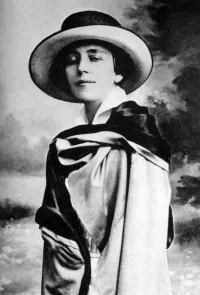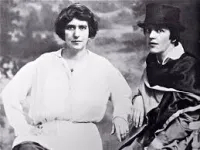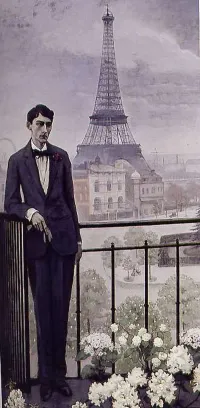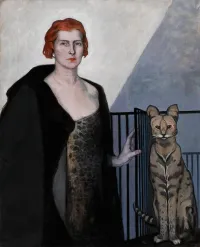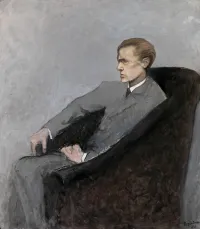Biography
1874 - 1970
"I am not inclined to believe that my disobedience was inspired by a spirit of rebellion. I was too young and friendless. Rather, I think that my desire to draw, stimulated by opposition, was stronger than any fear of punishment. In the long run, however, sufficient chastisement was meted out to discourage any further efforts when my mother was about. I soon understood that she was hostile to the slightest show of intelligence, and even more so to any display of personal talent."
- Romaine Brooks
Born in Rome to a wealthy and highly dysfunctional family – Beatrice Goddard was abandoned and abused before eventually inheriting a fortune. In 1902 she married homosexual pianist John Ellingham Brooks, leaving him after 3 months. She took his last name, changed her first name, and became Romaine Brooks. She studied art in Paris, Rome, and Capri – but discovered her color scheme on the Cornish Coast. Returning to Paris in 1905 with a subdued palette dominated by grays, she primarily painted portraits. Her first solo show consisted of 13 pieces, including two female nudes, quite bold for a female artist in 1910. During WWI she painted ‘The Cross of France,’ symbolic of the nation at war, and received the Chevalier medal from the French Legion of Honor for her war efforts. Brooks brought a visibility to lesbian identity through her renderings of androgynous, oftentimes crossed-dressed, usually powerful and self-possessed women. Her most reproduced painting is a grim self-portrait (1923) in top hat and riding clothes. She was romantically involved with ballerina Ida Rubenstein, writer/politician Gabriele D’Annunzio, and shared a 50-year relationship with Natalie Clifford Barney - though Brooks maintained she was only fully herself when alone. After solo exhibits in Paris, London, and New York in 1925 she did only 4 more paintings, including a series of 100 single line drawings formed from a continuous curving line, created in 1930. She wrote two unpublished memoirs and settled in a villa outside of Florence in 1937. Increasingly reclusive and eccentric, she eventually refused to see even Barney. Romaine Brooks died in Nice, France in 1970 at the age of 96. Her work remains on permanent display at the Smithsonian Institute in Washington, D.C.
1874 - 1970
"I am not inclined to believe that my disobedience was inspired by a spirit of rebellion. I was too young and friendless. Rather, I think that my desire to draw, stimulated by opposition, was stronger than any fear of punishment. In the long run, however, sufficient chastisement was meted out to discourage any further efforts when my mother was about. I soon understood that she was hostile to the slightest show of intelligence, and even more so to any display of personal talent."
- Romaine Brooks
Born in Rome to a wealthy and highly dysfunctional family – Beatrice Goddard was abandoned and abused before eventually inheriting a fortune. In 1902 she married homosexual pianist John Ellingham Brooks, leaving him after 3 months. She took his last name, changed her first name, and became Romaine Brooks. She studied art in Paris, Rome, and Capri – but discovered her color scheme on the Cornish Coast. Returning to Paris in 1905 with a subdued palette dominated by grays, she primarily painted portraits. Her first solo show consisted of 13 pieces, including two female nudes, quite bold for a female artist in 1910. During WWI she painted ‘The Cross of France,’ symbolic of the nation at war, and received the Chevalier medal from the French Legion of Honor for her war efforts. Brooks brought a visibility to lesbian identity through her renderings of androgynous, oftentimes crossed-dressed, usually powerful and self-possessed women. Her most reproduced painting is a grim self-portrait (1923) in top hat and riding clothes. She was romantically involved with ballerina Ida Rubenstein, writer/politician Gabriele D’Annunzio, and shared a 50-year relationship with Natalie Clifford Barney - though Brooks maintained she was only fully herself when alone. After solo exhibits in Paris, London, and New York in 1925 she did only 4 more paintings, including a series of 100 single line drawings formed from a continuous curving line, created in 1930. She wrote two unpublished memoirs and settled in a villa outside of Florence in 1937. Increasingly reclusive and eccentric, she eventually refused to see even Barney. Romaine Brooks died in Nice, France in 1970 at the age of 96. Her work remains on permanent display at the Smithsonian Institute in Washington, D.C.
Demography
Demography
Gender Female
Sexual Orientation Bisexual
Gender Identity Cisgender
Ethnicity Caucasian/White
Nations Affiliated France Italy United States
Era/Epoch Art Deco (1910-1940) World War I (1914-1918)
Field(s) of Contribution
Art
Commemorations & Honors
French Legion of Honor Chevalier Medal For World War I Efforts
Smithsonian Institute Permanent Collection Status
Demography
Gender Female
Sexual Orientation Bisexual
Gender Identity Cisgender
Ethnicity Caucasian/White
Nations Affiliated France Italy United States
Era/Epoch Art Deco (1910-1940) World War I (1914-1918)
Field(s) of Contribution
Art
Commemorations & Honors
French Legion of Honor Chevalier Medal For World War I Efforts
Smithsonian Institute Permanent Collection Status
Resources
Resources
Breeskin, Adelyn Dohme. Romaine Brooks. 2nd ed. Washington, D.C.: dist. for the National Museum of American Art by the Smithsonian Institution Press, 1986.
Chadwyck, Whitney. Amazons in the Drawing Room. Essay by Joe Lucchesi. [Exhibition: June 29-September 24, 2000, National Museum of Women in the Arts; October 11, 2000-January 21, 2001, Berkeley Art Museum/Pacific Film Archive, University of California at Berkeley] Chesterfield, MA: Chameleon Books; Berkeley: University of California Press, 2000.
Elliott, Bridget. "Performing the Picture or Painting the Other: Romaine Brooks, Gluck and the Question of Decadence in 1923." Women Artists and Modernism. Katie Deepwell, ed. New York: Manchester University Press, 1998. 70-82.
Langer, Cassandra. "Transgressing Le droit du seigneur: The Lesbian Feminist Defining Herself in Art History." New Feminist Criticism: Art-Identity-Action. Joanna Frueh, Cassandra Langer, and Arlene Raven, eds. New York: HarperCollins, 1994. 306-326.
Lucchesi, Joseph Edward "'The Dandy in Me': Romaine Brooks's 1923 Portraits." Dandies: Fashion and Finesse in Art and Culture. Susan Fillin-Yeh, ed. New York: New York University Press, 2001. 153-184.
Secrest, Meryle. Between Me and Life: A Biography of Romaine Brooks. New York: Doubleday, 1974; London: Macdonald and Jane's, 1976.
Werner, Françoise. Romaine Brooks. Paris: Plon, 1994.
Resources
Breeskin, Adelyn Dohme. Romaine Brooks. 2nd ed. Washington, D.C.: dist. for the National Museum of American Art by the Smithsonian Institution Press, 1986.
Chadwyck, Whitney. Amazons in the Drawing Room. Essay by Joe Lucchesi. [Exhibition: June 29-September 24, 2000, National Museum of Women in the Arts; October 11, 2000-January 21, 2001, Berkeley Art Museum/Pacific Film Archive, University of California at Berkeley] Chesterfield, MA: Chameleon Books; Berkeley: University of California Press, 2000.
Elliott, Bridget. "Performing the Picture or Painting the Other: Romaine Brooks, Gluck and the Question of Decadence in 1923." Women Artists and Modernism. Katie Deepwell, ed. New York: Manchester University Press, 1998. 70-82.
Langer, Cassandra. "Transgressing Le droit du seigneur: The Lesbian Feminist Defining Herself in Art History." New Feminist Criticism: Art-Identity-Action. Joanna Frueh, Cassandra Langer, and Arlene Raven, eds. New York: HarperCollins, 1994. 306-326.
Lucchesi, Joseph Edward "'The Dandy in Me': Romaine Brooks's 1923 Portraits." Dandies: Fashion and Finesse in Art and Culture. Susan Fillin-Yeh, ed. New York: New York University Press, 2001. 153-184.
Secrest, Meryle. Between Me and Life: A Biography of Romaine Brooks. New York: Doubleday, 1974; London: Macdonald and Jane's, 1976.
Werner, Françoise. Romaine Brooks. Paris: Plon, 1994.

